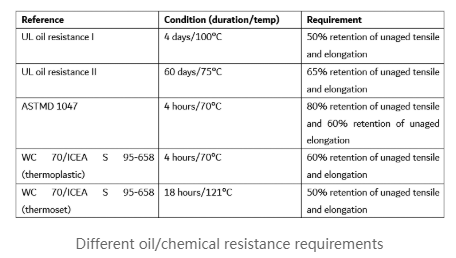Environmental resistance is critical in cable applications to ensure long-term performance, safety, and reliability. Cables are often exposed to harsh conditions such as water/moisture, chemicals, UV radiation, extreme temperatures, and mechanical stress. Selecting the right material with appropriate environmental resistance is essential to maintaining functionality and extending the service life of the cable.
This section explores the different types of environmental resistance required in various cable applications.
The outer jacket or sheath acts as the first line of defense against environmental factors. It is typically exposed to chemicals, water, temperature variations, and UV radiation. The main materials used for outer jacketing are PVC (Polyvinyl Chloride), PE (Polyethylene), and LSZH (Low Smoke Zero Halogen), each offering different levels of resistance depending on application requirements.
1. Chemical, Oil, and Hydrocarbon Resistance
During both installation and the operational life of a cable, exposure to chemicals, oils, or hydrocarbons can occur, either through accidental spills or continuous contact in industrial environments. Such exposure can degrade the outer sheath, leading to cracks, swelling, or loss of mechanical properties.
Selecting materials with strong chemical resistance is essential to ensure that the cable maintains its integrity, performance, and reliability throughout its lifetime.
Types of Chemical Exposure:
Gaseous Chemicals: Gaseous chemicals generally have lower reactivity with polymers as they do not deeply penetrate the material. However, reactive gases such as chlorine or ozone can cause surface degradation and significantly affect the polymer’s properties.
Liquid Chemicals: Liquid chemicals typically present a higher risk due to their ability to diffuse into the material. This can lead to swelling, plasticization, or internal chemical reactions within the polymer matrix, compromising mechanical and electrical properties.
Material Performance:
PE (Polyethylene): Offers good resistance to many chemicals and hydrocarbons. It performs well in general chemical environments but can be sensitive to strong oxidizing agents.
PVC (Polyvinyl Chloride): Exhibits very good resistance to oils, chemicals, and hydrocarbons, especially when formulated with appropriate oil-resistance additives.
LSZH (Low Smoke Zero Halogen): Provides moderate resistance to chemicals and oils. LSZH compounds are primarily designed for fire safety (producing low smoke and low toxicity during combustion). However, specialized LSZH formulations can achieve improved oil and chemical resistance when needed.
2. Water and Moisture Resistance
Cables are often exposed to water or high moisture environments during installation and throughout their service life. Prolonged exposure to moisture can lead to insulation degradation, corrosion of metallic components, and a reduction in overall cable performance.
Therefore, water resistance is a critical property for many cable applications, especially in outdoor, underground, or marine environments.
Among common jacketing materials, PE (Polyethylene) offers excellent water resistance, making it a preferred choice for applications requiring long-term protection against moisture ingress.
Low Voltage and Medium Voltage armoured cables with LSZH or PVC sheaths are generally not recommended for installation in permanently waterlogged environments, such as clay soils or areas below the water table. In contrast, PE sheaths greater resistance to the migration of water through the cable insulation. As a result, PE-sheathed cables are more suitable for wet conditions and are more likely to achieve their full design life.
Water-Tight Cable Design:
To achieve true water resistance in cables, two main protections are considered:
Radial Water Protection:
Achieved using materials such as lead metal sheaths or metal/metal laminated tapes combined with specialized polymers.
Longitudinal Water Protection:
Achieved using water-blocking tapes or powders that prevent the movement of water along the cable’s length.
Ingress Protection (IP) Rating and AD7/AD8 Class:
Detailed information about IP protection classes and ratings (such as AD7 or AD8) will be shared in a separate article.
3. UV Resistance
Understanding and selecting the appropriate environmental resistance for cable applications is crucial to ensuring long-term performance, safety, and reliability. Factors such as chemical exposure, water ingress, UV radiation, and temperature variations can severely impact cable integrity if not properly considered during material selection.
Choosing the right outer sheath material—whether PVC, PE, or LSZH—based on the specific environmental conditions can significantly enhance cable durability and service life. Additionally, implementing proper water-blocking techniques and considering IP ratings further strengthens cable protection in demanding environments.
By carefully evaluating these environmental resistances, cable systems can be better optimized for their intended applications, reducing maintenance needs, minimizing failure risks, and ensuring reliable operation throughout their expected life cycle.
Post time: Apr-27-2025


